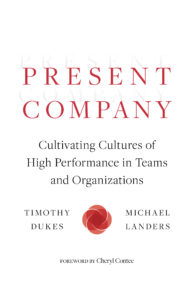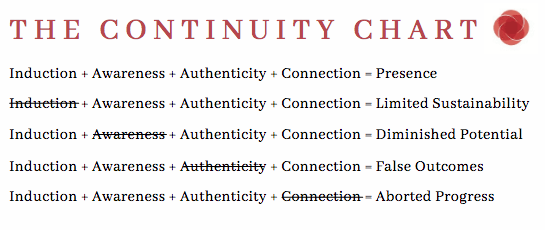Cultivate Leadership Presence
Have you ever been in the presence of someone who is…present? I mean, fully and completely present.
It’s so often the case that we are with people who are multi-tasking, drifting into thought, or focused on the past or the future. What about those who are fully with you in the now?
In Present Company, authors Timothy Dukes and Michael Landers share the four powers of presence: Induction, Awareness, Authenticity, and Connection.
They share how the art of presence can:
- Enhance your relationships
- Increase your creativity
- Increase your engagement
- Identify problem patterns
- Reduce insecurity and fears
- Increase focus
- Unify a team
- Cultivate respect
In order to get the most from the book, read it while….fully present. That seems obvious, but it certainly is important to say.
Michael Landers, MA, is the founder and president of Culture Crossing, Inc. He has worked with teams from all over the world to improve engagement. Timothy Dukes, PhD is a psychotherapist and leadership adviser. I reached out to talk more about their research and work.
What is a ‘present company’?
A present company isn’t a thing, it is a state of consciousness, a culture if you will, that is achieved and maintained by a group of individuals committed to engaging with awareness and authenticity over time.
When a company culture is the complete opposite of that, what are some of the common things you see?
Tim and I have found, through our work together, that there are several tell-tale signs indicating that a company needs to refocus, come into the present moment, and assess its culture. Here are a few:
- Territorialism that results in silos across business units and functions
- Fear of expressing your voice
- Competition when collaboration would better serve the team
- Regression into past wounds, problematic patterns, and storylines that lead to failure
- Avoiding and masking productive conflict with the rationale that the status quo is a better choice
What are a few of the benefits of a culture of presence?
When the teams we work with begin to achieve a level of presence here are a few of the results we start to observe:
- Improvement in cross-sector communication
- Reduction of insecurity and fears
- Constructive candor becomes a norm
- Leadership supports clear and effective complementary roles for senior leadership
- There is clarity around the organizational norms that bring about success
- There is a determination to develop a culture of mutual understanding
- Problematic patterns are identified, and everyone is committed to reducing their influence
- Teams are able to recognize the current capacity to stretch resources, systems, and processes and manage them effectively
- There is individual and team respect for co-determined leadership
- The potential to unify the leadership team is vastly increased
Achieving a present culture is not always easily accomplished. Moving from the challenges that we just mentioned to implementing the necessary changes takes commitment. More than that, it takes a roadmap.
As you work with an executive team, you can quickly assess where they are in the journey to presence. What do you look for?
Over the years, we have been engaged—both together and independently—by prominent executives and by team leaders seeking change. These clients have been searching for sustained high performance for themselves and for their teams. As a result of our work, we have become, in many instances, witnesses to internal cultural shifts. When successful in helping our clients, we observe individuals and teams engaging mindfully, when transitioning between team meetings and other interactions. We notice that people are attentive to their impact upon one another, recognizing how others are feeling in a given moment. We marvel at teams who choose vulnerability over masking or deflecting. And we easily detect when true multilateral connections exist among teammates.
Let’s touch base on The Four Powers of Presence: induction, awareness, authenticity, and connection. Must all four be present? Is one power more often missing or weak in corporate executives than another?
Each power has its own characteristics. When individually cultivated, they bring you value in your roles as both a leader and team member. However, when brought together as a unified and determined choice, they can take you to an expanded degree of success. When the Four Powers of Presence function together, there is a continuity that brings about presence. When one of the powers is missing, we find that it is immediately indicated in how it affects the potential within the team. We have a succinct chart to indicate our findings.
When the four powers are in residence, a team’s ability to stay present is greatly enhanced. As you transition from one moment to the next, the continuity of your interactions fosters the very architecture of a culture of presence.
In response to your question, there is one power that is often missing for corporate executives and that is Induction. What we see missing is the recognition of the necessity to transition, with awareness and authenticity from one meeting to the next, from one dialogue to the next, from one individual’s contribution to the next. An Induction is an invitation, a request, or a compelling demand to join and participate in something outside of yourself. It is an opportunity to shift your thinking and feelings as you engage with the thoughts and feelings of others.
Talk about present companies during the pandemic. As systems and people are overly stressed, how do we maintain the four powers?
Stress can serve you or work against you, depending how you deal with it. One of the main stressors of the pandemic can be alleviated by recognizing the need for inductions and transitions. Many of us sit in front of screens in much the same way that we watch TV or answer an email. Without awareness, we don’t make the transition to authentic engagement. Consequently, we don’t actually connect, or we do so to a limited degree. We have forgotten the need to make transitions from observer to participant. We can bring back authentic connection or engagement by paying attention and following a few simple guidelines. You can practice the art of induction in your personal life as well as applying it to your team dynamics:
- Take a moment, a pause, a breath, a moment of stillness, before beginning. Practice accepting silence.
- Be willing to risk simple expressions of kindness.
- Acknowledge what is present in the room you are sitting in as well as the context of the others in the meeting. How is the weather, their family, is everyone safe?
- Remember, listen deeply. Be attentive, with all of your senses. Takes notes about what is being communicated as well as what is happening in your own experience of the meeting.
- Allow yourself to live into the questions, without prematurely seeking solutions or answers. Do this beyond your comfort zone and wait to speak until you can no longer contain yourself, and then wait a little longer.
- Acknowledge the journey—what brought your team to this moment, what you have been through together, where are you heading, and how will you get there?
- Show a form of gratefulness for the attendees. When it is true, gratitude has the potential to move people out of their expectations to observe and be fed information to a place where they resonate with the authentic message. If people feel valued, they will engage.
- It is often helpful to have quick check-ins prior to starting the scheduled agenda.
- Set the stage, arrange the agenda so it is easily comprehended by the participants. Adjust camera, tune your audio, pay attention to the lighting, start and end on time. By doing this you have established the container, a set of predictable norms for this and future meetings.
Timothy Dukes, you wrote The Present Parent Handbook to help parents slow down and show up. I’m curious about your observations with people at home and at work. Do these skills translate well into other environments or must we learn them anew?
The Present Parent Handbook is a short, empathetic guide to conscientious parenting. It encourages parents to consistently locate themselves into the child’s world. This incidental time weaves connectedness with the parent so that as the child grows and develops, they do so in a context of safety where things simply make sense. Present company encourages leaders to do the same. Show up and start fresh in every moment with transparency and authentic engagement. Presence is the result of team members functioning with awareness and a determination to sustain regenerative and on-going engagement and connection where challenges are addressed collectively, and the organization successfully grows and develops. Yes, the skills and capacity to parent with presence are much the same for a present leader.
Michael Landers, you wrote Culture Crossing to help leaders work more globally and with a multicultural view. How do you see these two books working together?
They work hand in hand. Both provide readers with an opportunity to become more self-aware. Culture Crossing allows for an exploration into cultural programming and how it affects how we perceive the world around us. Present Company brings that experience into how we transition to and show up in that next moment—with a keen eye on the impact this may have on those around us.
For more information, see Present Company.
Image Credit: Ava Sol.


